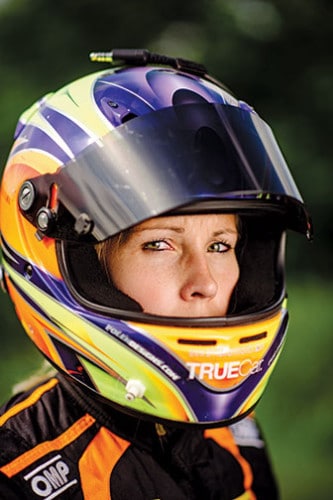SEPTEMBER/OCTOBER 2016
STORY BY Elizabeth Heubeck PHOTOGRAPHY BY Mary C. Gardella
My mother grew up in Baltimore City in the 1950’s, relying on trolley cars and good shoes to get her where she needed to go. Then she married my father and moved to a newly developed suburban 
Recently, women have begun to take over the driver’s seat, literally. As of 2014, women in all age groups 25 and older possess the majority of drivers’ licenses in the U.S. (51 percent, according to a report by the market research company Frost & Sullivan). Females also now purchase cars at a greater rate than males and influence 85 percent of car purchasing decisions, according to a recent NBCUniversal poll. And that’s not all. An increasing number of women are choosing professions that require extreme mastery behind the wheel. Two professional drivers who reside in Howard County share what it’s like to be among this small but growing cadre of women at the wheel.
DRIVEN TO COMPETE
Twenty two- year-old Clarksville resident Emilee Tominovich’s foray into race car driving started by accident or, more precisely, because of an injury. A highly competitive high school soccer player with an eye toward collegiate athletics, Tominovich found herself sidelined with numerous injuries during her junior and senior years. As a distraction, she began to tag along with her father to car races at New Jersey Motorsports Park and other regional tracks. Soon, she was hooked. For her high school graduation gift, Emily’s parents paid for her to attend prestigious Bertil Roos Racing School, making her eligible to obtain a Sports Car Club of America (SCCA) Regional Racing license. Shortly afterwards, she 
In her very first race on the amateur racing circuit, Tominovich finished a respectable second. She was soon noticed by Truecar.com, which was launching their Women Empowered Initiative by sponsoring six female race car drivers. In 2012, Tominovich became the youngest member of the professional team, racing in the Mazda MX-5 Cup series two years in a row. Race car driving, she says, is a very different sort of athletic experience than she’d been used to. “It was a huge transition, mentally,” she explains. “In soccer, I was used to feeding off the energy of other players. Here, you’re sitting in a car by yourself. You really have to dig within yourself.” The physical conditioning required for racing also differs from soccer. “You do need to be fit. You want to be small but as strong as possible. With so much power and torque, it’s like fighting a bull,” Tominovich says. Adding to the physical challenge is the extremely hot temperature inside the cockpit, which can exceed 120 degrees Fahrenheit during races. But to Tominovich, it’s worth it.
“The speed is addicting,” says Tominovich, who reports reaching speeds of 150 mph on straightaways; 90 mph on curves. So too is the competition inherent to the sport. “It’s you fighting up to about 30 cars,” she points out. Tominovich continued to pursue professional race car driving while attending Catholic University. In 2013, she represented the U.S. at the prestigious FIA Women in Motorsports Scirocco R Cup evaluation in Oschersleben, Germany, competing with the best female drivers in the world for a scholarship to fund the upcoming racing season. She narrowly missed out on winning the scholarship, but continued to be a diligent student, graduating with a Bachelor of Science in Nursing. Today, she is contemplating getting her masters’ degree in kinesiology. And while she’s not ruling out a return to the race track as a professional, she is aware of how hard it is to make a living as a race car driver.
Tominovich cites sponsorship funding – not gender bias – as the biggest challenge to a successful racing career. While she’s known female race car drivers who experienced unfair treatment, she says she never experienced gender-based discrimination on or off the track. In fact, she points out, being female “makes you a bit more of an interesting story.” Stories of female race car drivers aren’t unheard of, although women certainly comprise a minority presence on most speedways and have for several decades. Sara Christian was one of the first known female professional race car drivers, and the first female NASCAR driver in history. Beginning her racing career in 1949 at Charlotte Speedway, she competed against her husband and finished a respectable 13th place out of 33. That same season, she drove in a Daytona Beach race in which two other women – Ethel Mobley and Louise Smith – also took to the track. More recently, Danica Patrick has become a popular figure in the world of race car driving; in 2005, she became the first women to hold the lead during the famed Indianapolis 500.
A TRUCK DRIVER WITH A FLAWLESS RECORD
While a lack of financial support put the brakes on Tominovich’s motorsport career, fellow Howard County resident Annette Womack says her driving career will provide lifelong financial 
Womack, who’s 54, learned to drive a truck when she was in her early 20s. A friend of her father’s had a trucking company in Manassas, Virginia, where she grew up, and her father suggested she give it a try. She’s been in the driver’s seat ever since – joining the small but growing fleet of females that comprises nearly 6 percent of all U.S. truck drivers, according to the American Trucking Association.
A petite woman with a slight Southern accent who never goes to work without her makeup on, Womack has worked as a truck driver for multiple companies over the years. An employee of Giant Food since 1995, when she joined the organization, Womack has received plenty of accolades for her work ethic and safety record. Most notably, she earned the 2016 Maryland Motor Truck Association’s Driver of the Year for driving more than 1.7 million accident free miles in 30 years on the road. To those who’ve worked with Womack, the award came as no surprise.
“She is always looking at things happening at the store level that could impact our drivers, thinking of improvements that could be made at the stores that would allow drivers to get in and out more easily and help reduce accidents,” says Billye Pounds, senior manager for Human Resources at Giant Food. Indeed, Womack
Womack concedes that she’s slow to reveal her profession to casual acquaintances because she’s wary of being judged. Even so, she won’t hesitate to point out that she earns far more money than her sister, a college graduate. In overtime alone, Womack makes what some might consider a comfortable annual salary. Eying her future retirement, she contemplates living in London for part of the year; she travels extensively during vacations. Womack enjoys more than a comfortable lifestyle as a truck driver. As a member of the teamster’s union, she is paid the same as her male colleagues, she says. She hasn’t experienced any gender discrimination on the job, a fact she credits to Giant’s strict disciplinary system and the general respect she’s earned from her male colleagues. But Womack isn’t the type to dwell on whether she’s getting a fair shake. More often, she’s too busy making sure those around her are OK.





